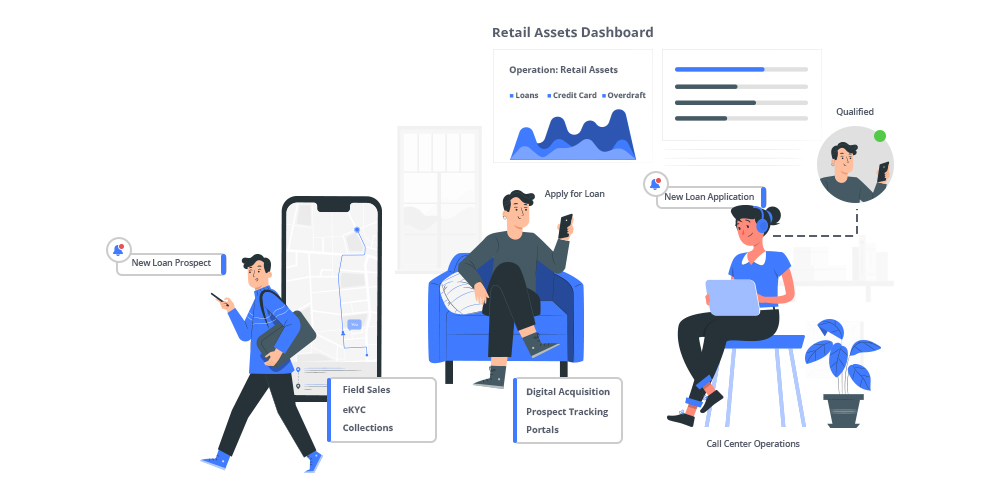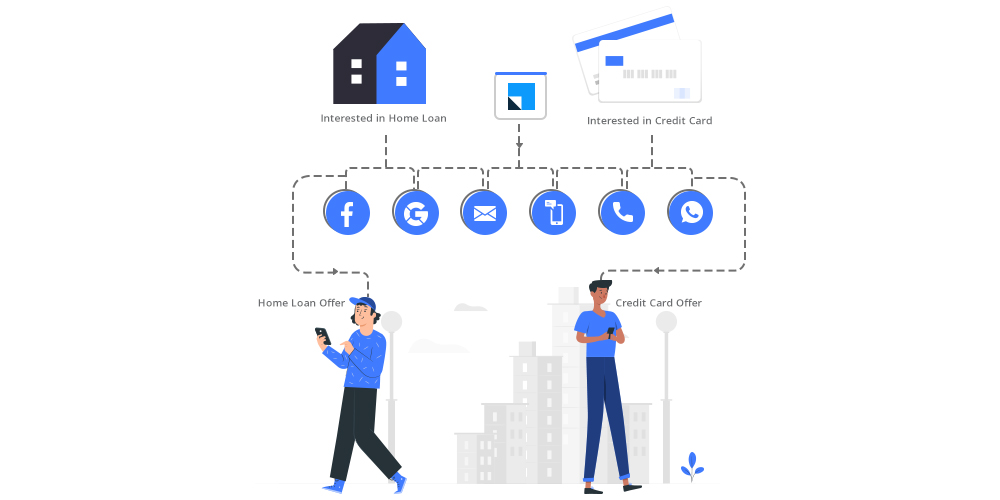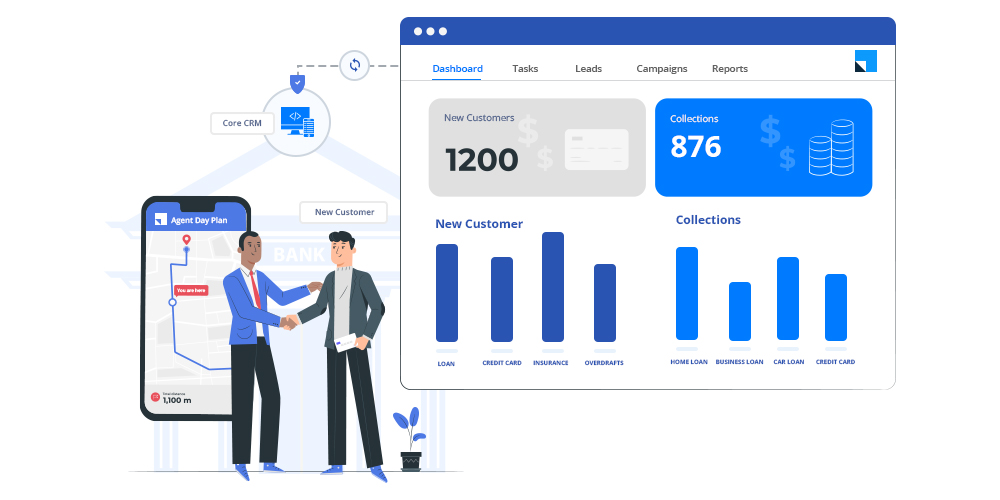

The banking sector’s future is shaped by digital business models. Digitization has caused a shift in customers’ behavior and preferences for conventional financial services. It has also elevated the competition by putting pressure on banks to become “digital first” to stay competitive.
73% of bank customers use digital services at least once a month, and the global digital banking market is estimated to reach 12 trillion USD by 2026.
As time goes on, we can expect many banks to evolve into tech companies that provide digital services, utilizing their extensive customer base and broad distribution networks. Many banking organizations have adopted customer-focused technology such as a CRM to improve their internal infrastructure and gain a competitive edge. If you’re still on the fence or are looking to adopt a tool, this article shares the advantages of a CRM in the banking sector to help you make a call!
Before we get into the advantages, let’s understand the challenges that are slowing down banking organizations.
Lack of digitization is one of the key issues that negatively affects customer satisfaction in the banking sector. It limits access to services, causes inconvenience, creates security risks, and makes it difficult to compare products and services. Customers may be frustrated, dissatisfied, and may even lose trust in the bank due to the lack of digital services.
Banks also face operational issues without the right digital tools to mediate back-end processes and customer-facing functions.
In conclusion, traditional banks are sorely lacking in both the software tools and the digital literacy that is required to compete with the modern fintech institutions. A Banking Customer Relationship Management (CRM) solution can play a significant role in the digitization of the banking sector by addressing several key challenges faced by banks. A CRM solution can help banks digitize their services and improve the overall customer experience, streamline processes, increase efficiency, improve cross-selling and upselling, and enhance customer engagement.
A Banking CRM is a centralized system that integrates with other banking software to provide a comprehensive view of every customer account. It records every customer interaction, including deposits, loan requests, and other pre-determined actions.
It is a software tool designed specifically for the banking sector that helps banks manage their customer interactions and relationships. It helps banks understand their customers’ needs and preferences, automate and streamline key processes, and provide a more personalized customer experience.
A banking CRM solution typically integrates with other systems used by banks, such as core banking systems and marketing automation tools, to provide a comprehensive view of customer interactions and data. It can also help banks engage customers through multiple channels, such as email, social media, and mobile, and provide real-time insights into customer interactions and feedback.
Here are some of the key benefits of implementing a dedicated banking CRM solution.
A comprehensive overview of each customer can be obtained through a banking CRM. This is achieved by integrating the CRM with various banking software applications, creating a unified system that offers a single view of all customer accounts.
Any pre-determined actions taken by customers, such as using an ATM or inquiring about a specific loan, can be recorded in the CRM. This allows businesses to gain deeper insights into customers’ habits and personal preferences, enabling them to match financial products to their goals more easily.
Given the abundance of private banks available, customers often use multiple banks to meet their various financial needs, rather than relying on a single bank. To stand out from the competition, providing a personalized customer experience is crucial.
A banking CRM eliminates gaps in the customer journey and allows banks to offer assistance from the moment a customer opens an account until they make transactions, apply for loans, and beyond. This helps banks value their customers’ business and meet their financial needs in a timely and efficient manner. Additionally, regularly following up with customers demonstrates that the bank cares about their relationship.

Banks should aim for a customer-focused business model that is tailored to their needs. A banking CRM helps categorize customers based on various factors such as gender, demographics, age, income, credit rating, and more. It also facilitates segmentation based on investment preferences, investment size, and length of the customer relationship.
This classification serves as a specific parameter to build a personalized approach. Doing so, significantly aid banks in reaching out to customers and fostering business relationships.

By using an appropriate Banking CRM, banks can deliver a digital-focused banking experience that customers expect. A CRM helps sales executives understand the intent for the customer, the type of loan he needs, previous engagements with the customer to estimate behavioral patterns, and other such insights to strategically sell. A banking CRM can also help in the context of omni-channel customer engagement, opportunity management, reports, lead management, and more.
The data accessible through the CRM tool can be integrated into reports that provide a thorough and strategic understanding of your customers. Bankers can effortlessly identify patterns, promotional campaigns, and areas of improvement to develop new strategies and customize future marketing initiatives.
Banks can leverage the information in their customer profiles to discover potential cross-selling and upselling prospects.
For instance, when a customer makes a deposit at the bank, the teller can access their complete profile and inform them of new products they may be eligible for or interested in, such as credit cards or exclusive loans.
With a Banking CRM solution in place, banking agents have access to a complete history of a customer’s interactions and activities. This enables them to assist the customer, resolving any issues and transforming challenges quickly and efficiently into opportunities for building loyalty and satisfaction.
To keep potential customers engaged, it is crucial to maintain consistent communication. A Banking CRM allows you to create personalized customer journeys and trigger automated emails based on specific actions. Dynamic templates can also be created to send offers tailored to the customer’s website activity.
Additionally, instant alerts can be set up to notify the appropriate team member when a lead performs a sales-friendly action. For example, if a prospect begins filling out a loan application but doesn’t complete it, an automated email can be sent or a salesperson can be notified to follow up manually.
Traditional methods of the loan origination process involves manual background verification through tele calling, which can be time-consuming and prone to errors. A robust banking CRM streamlines the entire process, making it easier for banks and their tele calling teams to have insight on past interactions with a borrower along with their financial portfolio for better decision making.
Furthermore, it’s important for banks to evaluate the eligibility of a loan applicant. Banks have their own criteria, such as credit score, income, employment, etc. With a CRM, the eligibility check of potential borrowers can be automated with knock-out rules, leads can be distributed to relationship managers efficiently, and much more.
The use of a real-time Banking CRM system makes it simple for bank representatives to record customer information and makes follow-ups much easier. They can also determine the products that are generating the most revenue in different locations. This helps them keep track of what is successful and what is not.
For example, a significant increase in loan disbursals in a specific area may indicate a positive impact, and they can easily find out why. If there is a decrease in credit card purchases, they can offer ones with more discounts.
With online banking readily accessible, bankers should be able to provide personalized services and experiences to their customers proactively. The omnichannel experience of a CRM system enables efficient management of customer interactions through calls, chat, email, social media, and mobile applications, thereby enhancing customer service.

The CRM tool can simplify a banker’s life by centralizing all data in one place. It helps keep all bank departments on the same page, eliminating the need for customers to go from department to department. The right CRM can also provide a digital experience that matches the expectations of customers in a face-to-face encounter with their banker.
The CRM can track data from multiple departments, enabling it to prepare future customers. Interdepartmental leads can also be smoothly managed without having to start a new conversation each time.
The CRM tool provides real-time data that allows banks to make informed decisions about their next steps. The key is to remember effective strategies boost customer satisfaction! By prioritizing customer needs and resolving issues promptly, a bank can differentiate itself from its competitors.
A Banking CRM can highlight touchpoints, negative interactions, or areas of concerns to reduce customer churn. By tracking lead activity and status, these issues can be resolved early on to retain your relationship with the customer and may even improve it.
Well, these advantages can turn your business around but before you get to these results, you need to implement the right banking CRM for your business. But don’t worry, the next segment will address all your concerns about implementing a banking CRM.
To implement a Banking CRM, one needs to define their goals and objectives, identify the target audience, evaluate CRM options, plan for data migration, train employees, launch and continuously monitor how it impacts performance. It is a complex process that requires careful planning and execution to ensure its success
Traditional banks’ workflows must be optimized for automation. This can eliminate numerous manual procedures and force many employees to change positions. Initial training is also required for the implementation of a banking CRM.
Here are a few measures banks may take to improve their workflow for automation.
In a financial organization, rethinking old procedures for automation should be done in stages. It can, however, assist to streamline procedures, boost efficiency, and improve the customer experience. To establish an automated process, a comprehensive strategy including the latest technologies and best practices is required.
While most banks have their own requirements, all banking CRM solutions should have some core features. Understanding these features and what works for your business can be overwhelming, but you can check out this guide to before finalizing a CRM.

Here are the 10 key CRM features that are key for banking organizations:
A Banking CRM is vital for banking services because it enables banks to manage their client connections effectively and efficiently. It offers a consolidated platform for storing customer data and recording interactions, which can then be analyzed to determine consumer behavior and preferences. This data can then be utilized to enhance the customer experience, boost customer loyalty, and drive revenue development.
LeadSquared’s tailored Banking CRM covers all the features you need and more configured to your business requirements. You can check out the product specifications, implementation period, and pricing by getting in touch with our team today!